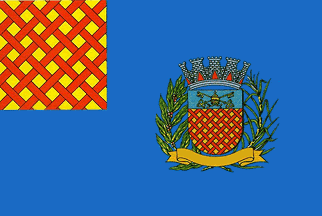 image by
Dirk Schönberger,
7 February 2013
image by
Dirk Schönberger,
7 February 2013Based on: http://www.saopedro.sp.gov.br/Municipio/Page.aspx?tipo=simbolos

Last modified: 2013-03-02 by ian macdonald
Keywords: sao paulo | são pedro |
Links: FOTW homepage |
search |
disclaimer and copyright |
write us |
mirrors
 image by
Dirk Schönberger,
7 February 2013
image by
Dirk Schönberger,
7 February 2013
Based on:
http://www.saopedro.sp.gov.br/Municipio/Page.aspx?tipo=simbolos
A blue flag with a yellow canton bearing red woven fretwork with the municipal arms in the fly.
Official website at
http://www.saopedro.sp.gov.br
Dirk Schönberger,
7 February 2013
São Pedro was founded by Joaquim, José and Luiz Teixeira de Barros, from Itu, who purchased the Pinheiros domain. The Teixeira de Barros brothers erected a chapel dedicated to St. Sebastian and named the nearby settlement Capela do Picadão. A trail cleared in the primary forest ("picadão") in 1725 linked São Paulo to Cuiabá mines. Due to the danger represented by the natives and the wild animals, the provincial government decided to build inns ("pousos") in which the users of the trail could safely overnight. The Pouso do Picadão, once located on the site of today's São Pedro downtown, was established on a hill between rivers Pinheiro and Samambaia; it was originally managed by Floriano da Costa Pereira, aka Florianão. The patron saint of the new settlement was soon changed for St. Peter. The parish of São Pedro was established in 1864. The municipality of São Pedro was established in 1881, seceding from Piracicaba.
São Pedro is the birth town of the poet Gustavo de Paula Teixeira (1881-1937), known as the Roses' Poet. The poet, usually considered as a Parnassian and Symbolist, was elected at the Paulista Academy of Letters in 1937 but passed away before his inauguration. The writer Maria de Lourdes Teixeira (1907-1989), also borne in São Pedro, was the first woman elected at the Paulista Academy of Letters.
The flag is blue with the municipal coat of arms and a yellow canton fretted of 14 red pieces. The dimensions of the flag are 14 units c 20 units. The height of the coat of arms is 8 units. The dimensions of the canton are 7 units x 7 units.
The coat of arms of São Pedro, designed by Lauro Ribeiro Escobar, is prescribed by Municipal Law No. 934 of 24 October 1972. "Rounded-off shield, or fretty gules of 14 pieces a chief azure charged with two keys per saltire all over a Papal tiara all or. The shield surmounted by an eight-towered mural crown argent ports gules. The shield supported dexter by a branch of coffee and sinister by a sugarcane proper. Beneath the shield a scroll or inscribed with the motto 'FIDE ET LABORE PATRIAE MAGNITUDO' in letters sable."
The rounded-off, or Iberic shield, used in Portugal at the time of
discovery of Brazil, is a tribute to the first colonizers and builders
of the country.
Or is a symbol of wealth, splendour, generosity, glorious nobleness,
power, force, sovereignty and rule.
The frets evoke the fences set up on the early limits of the
municipality. Gules is a symbol of valour, courage, intrepidity,
valiance and honour.
Azure is a symbol of incorruptible firmness, glory, virtue, sweetness,
dignity, perseverance, zeal and loyalty, as well as of the healthy
climate of São Pedro and its sky always blue and limpid. The keys and
the tiara make the arm canting, since the Keys of the Kingdom of
Heavens are a symbol of the temporal power, attribute of Pope St.
Peter, the town's namesake.
The mural crown is a symbol of municipal emancipation. The open ports
are a symbol of hospitality. Gules is the colour of Law and Justice,
meaning that São Pedro is the seat of a "comarca" and recalling the
dictum "Justice is Found Through These Ports".
The branch of coffee and the sugarcane emphasize the fertility of the
soil, being the main crops in the municipality.
The Latin motto reads "We Increase the Nation Through Faith and Labour".
Ivan Sache, 16 February 2013